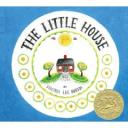Once upon a time
there was a Little House
way out in the country.
She was a pretty Little House
and she was strong and well built.
Virginia Lee Burton’s classic, The Little House, was the winner of the prestigious Caldecott Medal in 1943. The pretty Little House sat on a hill and watched the countryside around her. The whimsical and detailed artwork and lyrical and nostalgic wording brings the Little House to life as she becomes the main character of this story of change over time.
She watched the sun rise in the morning
and she watched the sun set in the evening.
Day followed day,
each one a little different
from the one before€¦€¦.
We experience the changes of the sun, moon, and seasons, and the change of her surroundings as the lights of the city grow closer to the Little House. Eventually a road is built in front of the house. This is followed by gasoline stations, roadside stands, and more little houses. " Everyone and everything moved much faster now than before." Then the countryside was changed as apartments and tenement houses, schools, and stores began to spread over the land. It became so crowded that she couldn't tell when Spring, Summer, Fall, or Winter came.
Then one day the great-great-granddaughter of the man who built the Little House sees the house and remembers stories that her grandmother told about living in just such a house, far out in the country. When the great-great-granddaughter discovers that it is the same house, she arranges to have her moved out of the city, to a hill in the country.
Once again she could watch
The sun and moon and stars.
Once again she could watch
Spring and Summer
And Fall and Winter
Come and go.
Curriculum Connections
The Little House can be used to introduce and/or enhance many of the earth science Standards of Learning. The students can observe the countryside slowly change with the seasons through both the words in the story and the wonderful pictures. (VA SOL 1.7 & 2.7). The book has a wonderful illustration of the cycle of the sun rising and setting in the sky that can illustrate the basic patterns and cycles occurring in nature, such as day and night. Simple phases of the moon are also illustrated, including a simple calendar illustration of the moon cycles. (VA SOL 3.8a) Earth Resources can be investigated as the story explores how human influences affected the area around the little house and connect that to animals & plant life that may have lived around the house and how they may have been affected by these changes. (VA SOL 3.10)
Additional Resources
- The Four Seasons Tree Collage activity allows students to be creative and make a tree as it would look in one of the four seasons.
- Star Date Online provides a moon phase calendar for any given month. This can be compared to the moon phase calendar provided in the book.
- Harcourt School provides an online, interactive moon phase activity, a graphic of the phases of the moon, and an interactive seasons activity to explore different aspects of each season.
- Science U provides Seasons reasons, a great description & illustration of the movement of the earth that causes the seasons.
General Information
Book: The Little House
Author/Illustrator: Virginia Lee Burton
Publisher: Houghton Mifflin Company
Publication Date: 1942
Pages: 44
Grade Range: PreK – 3
ISBN-10: 039525938X
ISBN-13: 978-0395259382

